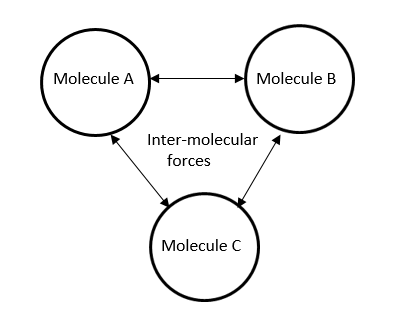Answer
416.7k+ views
Hint: Intermolecular forces are the very important one because they determine the physical property of the many objects such as solid, liquid and gas. Intermolecular forces play an important role in science and regular life. Because the hydrogen bond is more important so that the water is produced.
Complete step by step answer:
The force between the molecules is known as intermolecular forces. Intermolecular forces are observed between the atoms and molecules. Intermolecular forces are electrostatic in nature and also having other forces includes van der Waals forces and hydrogen bonds. Based on the intermolecular forces, the object may classify as solid, liquid and gas. In solids, the intermolecular forces are very high. In liquids, the intermolecular forces are slightly less than solids and in gas, the intermolecular forces very less.
In general, there are two types of intermolecular forces. They are Attractive intermolecular forces and Dispersive intermolecular forces. Attractive intermolecular forces are classified into Hydrogen bonding (H-Bonding) and Ionic bonding (Ion-induced dipole forces). Hydrogen bonds are the strongest intermolecular force. Dispersion intermolecular forces are the weakest intermolecular forces.
In solids the particles are arranged in some pattern. So, that the intermolecular forces are very high. In liquids, the particles are close together but not arranged in some pattern. So, that the intermolecular forces are less. But in gas, the particles are very far apart and not in regular arrangement. So, that the intermolecular forces are very less.

Significance of intermolecular forces:
1. Intermolecular forces are the very important one because they determine the physical property of the many objects such as solid, liquid and gas.
2. In solids, the intermolecular forces are attractive in nature. In liquids, the intermolecular forces are slightly attractive and slightly repulsive in nature. But in gas, the intermolecular forces are repulsive in nature.
Note:
The four key intermolecular forces are very important. They are Ionic bond, Hydrogen bond, Van der Waals dipole-dipole interactions, Van der Waals dispersion forces. These are the major and important intermolecular forces. Boiling points are a measure of intermolecular bonds. The intermolecular forces increase with increasing polarization of bonds.
Complete step by step answer:
The force between the molecules is known as intermolecular forces. Intermolecular forces are observed between the atoms and molecules. Intermolecular forces are electrostatic in nature and also having other forces includes van der Waals forces and hydrogen bonds. Based on the intermolecular forces, the object may classify as solid, liquid and gas. In solids, the intermolecular forces are very high. In liquids, the intermolecular forces are slightly less than solids and in gas, the intermolecular forces very less.
In general, there are two types of intermolecular forces. They are Attractive intermolecular forces and Dispersive intermolecular forces. Attractive intermolecular forces are classified into Hydrogen bonding (H-Bonding) and Ionic bonding (Ion-induced dipole forces). Hydrogen bonds are the strongest intermolecular force. Dispersion intermolecular forces are the weakest intermolecular forces.
In solids the particles are arranged in some pattern. So, that the intermolecular forces are very high. In liquids, the particles are close together but not arranged in some pattern. So, that the intermolecular forces are less. But in gas, the particles are very far apart and not in regular arrangement. So, that the intermolecular forces are very less.

Significance of intermolecular forces:
1. Intermolecular forces are the very important one because they determine the physical property of the many objects such as solid, liquid and gas.
2. In solids, the intermolecular forces are attractive in nature. In liquids, the intermolecular forces are slightly attractive and slightly repulsive in nature. But in gas, the intermolecular forces are repulsive in nature.
Note:
The four key intermolecular forces are very important. They are Ionic bond, Hydrogen bond, Van der Waals dipole-dipole interactions, Van der Waals dispersion forces. These are the major and important intermolecular forces. Boiling points are a measure of intermolecular bonds. The intermolecular forces increase with increasing polarization of bonds.
Recently Updated Pages
Draw a labelled diagram of DC motor class 10 physics CBSE

A rod flies with constant velocity past a mark which class 10 physics CBSE

Why are spaceships provided with heat shields class 10 physics CBSE

What is reflection Write the laws of reflection class 10 physics CBSE

What is the magnetic energy density in terms of standard class 10 physics CBSE

Write any two differences between a binocular and a class 10 physics CBSE

Trending doubts
Difference Between Plant Cell and Animal Cell

Give 10 examples for herbs , shrubs , climbers , creepers

Name 10 Living and Non living things class 9 biology CBSE

Difference between Prokaryotic cell and Eukaryotic class 11 biology CBSE

Fill the blanks with the suitable prepositions 1 The class 9 english CBSE

Change the following sentences into negative and interrogative class 10 english CBSE

Write a letter to the principal requesting him to grant class 10 english CBSE

Fill the blanks with proper collective nouns 1 A of class 10 english CBSE

Write the 6 fundamental rights of India and explain in detail



